Frontiers of Taxonomy: The Many-Helmeted Guineafowl, an Awkward Foursome

“Tufted Guineafowl.” © copper
The Helmeted Guineafowl (Numida meleagris) could be regarded as one extremely variable species or as several species inappropriately sharing one name. As of 2020, the taxonomic consensus is to sort the nine recognized subspecies into four distinct forms:
“West African Guineafowl” (galeatus) of tropical western Africa and widely introduced elsewhere;
“Ethiopian Guineafowl” (meleagris and somaliensis) of central and eastern Africa in the Sahel and south to Rwanda and Kenya;
“Reichenow’s Guineafowl” (reichenowi) of Kenya and Tanzania;
“Tufted Guineafowl” (mitratus, marungensis, papillosus, and coronatus) of southern Africa north to Angola, Rwanda, and Tanzania, and introduced to Madagascar.
The differences among these forms are remarkable and make them likely candidates for reclassification as separate species. A fifth form, the “Moroccan Guineafowl” (sabyi), formerly of North Africa, appears to have gone extinct in the 1900s (but apparently persists through diluted remnants in feral and domestic stock), and it is perhaps more accurately classified as a subspecies of “West African.”
The four extant forms differ dramatically in their signature headgear. Or to put it another way, the forms wear entirely different helmets—such different helmets that it is difficult to imagine that a contemporary ornithologist would classify them as a single species. More than just their helmets, the forms also differ dramatically in the colors and patterns of their bare facial skin and dewlaps, and in the shapes, locations, and colors of various additional fleshy growths on their heads, but each of the forms is internally consistent:
“West African” has a small brown casque (usually little more than a triangular cap), whitish facial skin, and a “handlebar moustache” that consists of a long, broad, curled, red wattle on each cheek with a fleshy red connection across the cere.
“Ethiopian” has a small-to-medium-sized brown casque, bluish facial skin, and a cluster of bristles on the cere.
“Reichenow’s” has a very tall orange-brown casque, turquoise facial and neck skin, a black dewlap, and a “handlebar moustache” that consists of a long, broad, curled red wattle on each cheek, and a fleshy red connection across the cere.
“Tufted” has a tall orange-brown casque with a heavily carunculated red base and cere, turquoise facial and neck skin, a dark-blue or violet dewlap, and long, thin, pointed cheek-wattles that are bluish with red tips.
On the surface, these are four distinctly different-looking birds that maintain sufficiently separate breeding populations that the differences between their appearances remain pronounced and consistent.
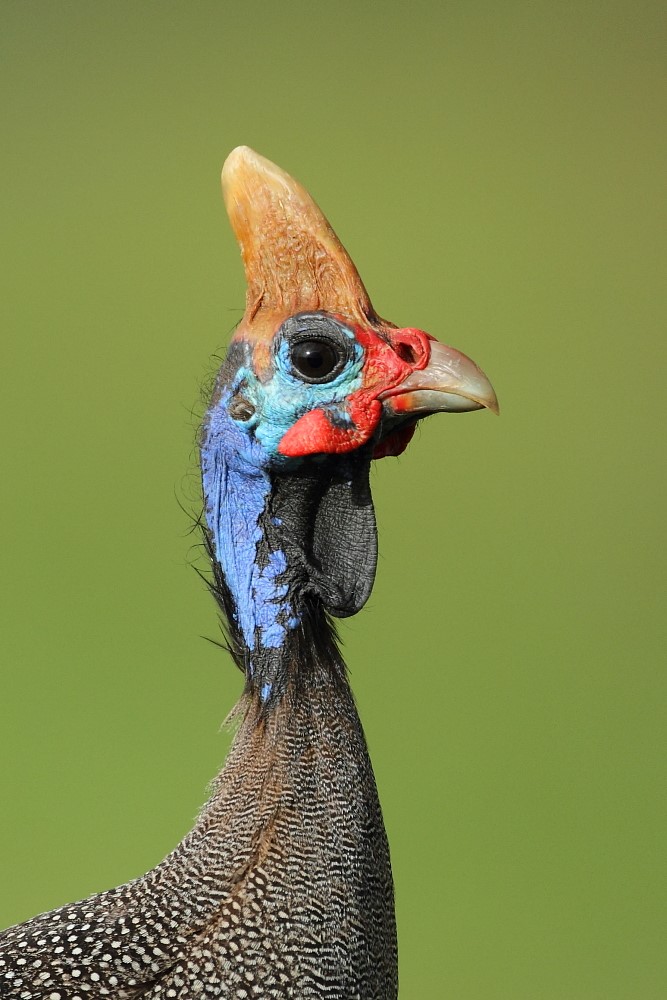
“Reichenow’s Guineafowl,” N. m. reichenowi, the champion of helmets, showing its distinctively tall orange-brown casque, red caruncles, turquoise cheeks, purplish neck-skin, and black dewlap. (Tarangire National Park, Tanzania; February 2, 2013.) © Darran Rickards
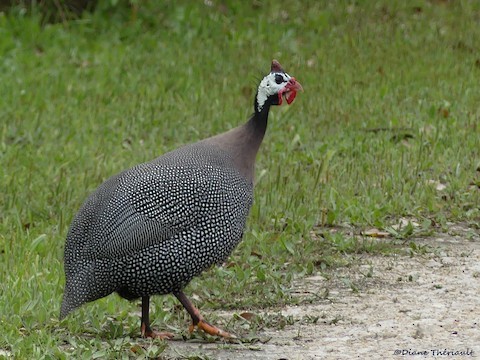
“West African Guineafowl,” N. m. galeatus, showing distinctive white facial skin, small casque, and red “handlebar moustache.” (Goose Island State Park, Texas; April 1, 2019.) © Diane Thériault
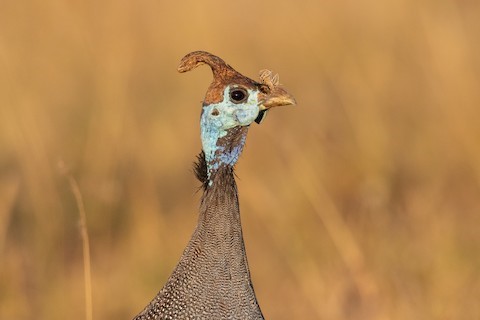
“Ethiopian Guineafowl,” N. m. meleagris, showing its small brown casque, bluish facial skin, and cluster of bristles on the cere. (Yabello, Oromia, Ethiopia; December 30, 2019.) © Stefan Hirsch

“Tufted Guineafowl,” N. m. mitratus, showing its orange-brown casque with a red base, red cere, turquoise facial and neck skin, a dark-blue dewlap, and long, thin cheek-wattles that are bluish with red tips. (Kruger National Park, South Africa; April 18, 2019.) © Guenther Karmann
In light of their pronounced and highly visible divergences, these forms would seem to qualify as different species. It also seems relevant that the nature of their distinctions are adornments that presumably play a strong role in sexual selection—not passive genetic drift, but rather the direct expression of selective pressure, a textbook example of speciation.
Standing athwart this apparently straightforward taxonomic correction is the fact that the forms have been known to interbreed in two contexts: (1) human-caused introductions and husbandry; and (2) apparently natural hybridization and intergradation in eastern Africa.
Human-Caused Interbreeding: The Helmeted Guineafowl might qualify as the first Afro-European poultry. Although it never rose to the domesticated prominence of the Red Junglefowl (Gallus gallus) in ancient Asia and the Pacific, guineafowl have also been kept captive and at least semi-domesticated for millenia.
Despite this deep history, however, domestic guineafowl stock does not appear to have drifted far from its wild phenotypes. Outside of Africa, most domestic guineafowl have the “West African” head pattern, or something very close to it—in fact, they seem to show more variability in plumage than in headgear, which suggests that these growths are not as plastic as they appear. Within Africa and elsewhere, most domestic guineafowl are recognizable as either “West African” or “Tufted,” with a few apparent hybrids between the two.
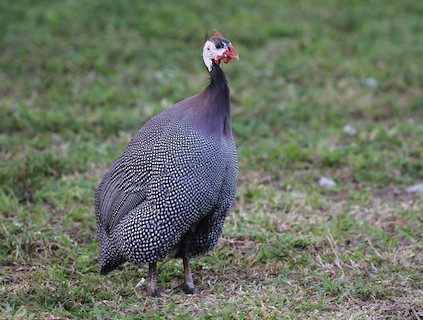
“West African Guineafowl,” N. m. galeatus, showing distinctive whitish facial skin, plump, red wattles, and small casque—all features that are generally characteristic of most domestic and feral guineafowl. (Fort Lauderdale, Florida; February 14, 2018.) © Alex Lamoreaux

Apparent hybrid between “West African” and “Tufted Guineafowl,” N. m. galeatus and papillosus. (Swakopmund, Erongo, Namibia; October 22, 2016.) © Louise Auclair
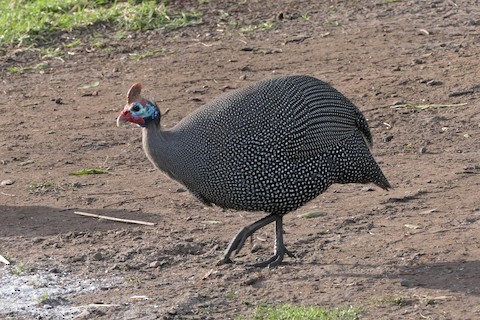
Apparent hybrid between “West African” and “Tufted Guineafowl,” N. m. galeatus and papillosus, with “West African’s” red handlebar moustache and cheek-wattles, and “Tufted’s” casque and facial skin color—this individual’s appearance is largely consistent with “Reichenow’s Guineafowl,” N. m. reichenowi, but the location strongly suggests that it is a hybrid of “West African” and ”Tufted.” (Wilderness National Park, Western Cape, South Africa; August 11, 2019.) © Ray Turnbull

Intergrade or hybrid of “Reichenow’s” and “Ethiopian Guineafowl,” N. m. reichenowi and meleagris, with “Reichenow’s” casque and “Ethiopian” coloration. (Samburu National Reserve, Kenya; June 5, 2018.) © Joan and/or George Sims
Natural Intergradation and Hybrids: Throughout most of Africa, the vast majority of wild Helmeted Guineafowl are recognizable as one form or another. Each form shows some internal variation—but the differences between the forms are clear and consistent, and can be articulated with little ambiguity. So the genetic boundaries appear generally stable.
The one conspicuous exception is the populations of central Kenya, which show noticeable intergradation of “Ethiopian” and “Reichenow’s.” Most appear to be predominantly “Ethiopian” with some “Reichenow’s” heritage evident in the shape, size, and color of the casque, but at least a few individuals appear to be 50/50 hybrids.
West of Lake Victoria, in the border region of Uganda, Rwanda, and Tanzania, there is some evidence of intergradation between “Ethiopian” and “Tufted”—although most appear to be predominantly “Ethiopian” with some “Tufted” heritage evident in the shape and color of the cheek-wattles.
As of 2020, the taxonomic consensus is that the intergradation between forms (mainly “Ethiopian” and “Reichenow’s”) indicates incomplete speciation, maintaining the historical classification of the Helmeted Guineafowl (Numida meleagris) as a single, internally diverse species. Considering the dramatic differences in their appearances, which persist despite millenia of human intervention in their reproduction and environment, it seems likely that the consensus will eventually tilt toward recognizing four species.

Apparent intergrade or hybrid of “Reichenow’s” and “Ethiopian Guineafowl,” N. m. reichenowi and meleagris, with “Reichenow’s” coloration except for the red cheek-wattles—but note that the coloration is mostly consistent with “Tufted Guineafowl” as well, including blue cheek-wattles with small dark (apparently red) tips. This population occupies an area between the ranges of pure “Ethiopian” and “Reichenow’s,” which suggests this mixture, but “Tufted” is also conceivable as a participant. (Lake Nakuru National Park, Kenya; September 23, 2019.) © Michel Bourque
Text © Russell Fraker / April 22, 2020